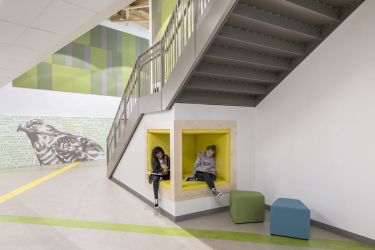|
Subscribe / Renew |
|
|
Contact Us |
|
| ► Subscribe to our Free Weekly Newsletter | |
| home | Welcome, sign in or click here to subscribe. | login |
Construction
| |

February 3, 2022
Lingering pandemic provides a new twist to trauma-informed design
Special to the Journal
Before the pandemic, trauma-informed design focused on the usual suspects: substance abuse, violence, homelessness, poverty and racism.
But life in the time of COVID-19 has augmented the checklist that architects and developers review when deciding how trauma-informed design should be incorporated in design and construction.
A recent field of practice, trauma-informed design (TID) focuses on shaping supportive learning and working environments. TID components include spaces that help traumatized children or adults.
In the realm of school design, TID can include safe rooms and spaces with flexible furniture, cozy corners, niches and nests, according to Lorne McConachie, a principal at Bassetti Architects.
McConachie said Bassetti Architects has been compiling best practices of trauma-informed design as a tool to assist designers and educators to think creatively about shaping supportive learning areas. These groups have developed a TID checklist compiled of research and lessons learned from trauma-informed care practitioners and educators.
With COVID-19, trauma-informed design is being further refined, McConachie said.
“COVID likely exacerbates everything about TID,” he said. “The pandemic is a significant source of trauma given the death, worry of getting sick, unemployment and general social alienation it has brought. We haven't thought through specific COVID patterns but I suspect the need for TID ratcheted up several notches over the past couple of years.”
For the new Walnut Grove Elementary School in Vancouver, Bassetti incorporated ideas from TID. The firms used a TID checklist as a means of critiquing and improving most of the firm's school designs in its Seattle and Portland offices.
“We have had an earnest interest in the TID ideas from leaders in Seattle Public School's facility department,” McConachie said. “We are currently working on the designs of Rainier Beach High School and Mercer Middle School for Seattle Public Schools and we have utilized the checklist to incorporate relevant ideas into those projects. Another project utilizing the checklist is Evergreen High School in the Highline School District.”
The TID checklist, he said, can be applied to higher education designs as well, since trauma impacts all ages and supporting college-age students is equally critical.
“One of the patterns in the checklist discusses some support strategies for teachers and counselors,” he said. “Adults dealing with traumatized students day-in and day-out can begin feeling stressed themselves and it's important that they have spaces where they can ‘reflect, center and get grounded' before going back to dealing with the stresses others are experiencing.”
The TID system can also be used for retrofitting schools. “An important example is an area of refuge where a student experiencing stress can calm down, center, fidget or otherwise collect their thoughts,” McConachie said. “This could take the form of a comfortable chair or beanbag in the corner of a classroom.”
A few other physical examples of TID are paint colors, controllable lighting, furniture flexibility, acoustic attenuation and more biophilic connections — from nature posters to more time outside, to school gardens.
To avoid what McConachie called the “herding cats” layouts of 20th century schools — in which students were given little or no trauma-reducing environments — designers are modifying TID rules as social awareness of trauma increases.
McConachie acknowledged, however, that when he gives presentations on TID to colleagues he queries audiences to see if there are any skeptics.
“To date, we have not heard any dissenting opinions,” he said. “There is no body of deep scientific research on the topic, although TIC has been around for a while and there are effective strategies within the methodologies developed by counselors and social workers.”
At the Association for Learning Environments' LearningSCAPES conference in October in Denver, attendees of a TID presentation offered anonymous feedback on 3-by-5 note cards. One participant wrote, “Have students always been struggling with trauma, or is this a recent occurrence?” while another contributed: “We've added alcoves in every classroom, with lighting controls and soft seating.”
“Layers of de-escalation are a good self-regulation option,” wrote another participant.
McConachie said architects have assembled the information for the TID checklist from a range of sources: research papers, articles on trauma, discussions with educators and TID practitioners.
“It is very much a work in progress and I feel it's critical to challenge ideas, report outcomes, both positive and negative, and improve the checklist based on effectiveness as we go,” he said. “We're early in the game, but the crisis facing too many kids is devastating and we had to start somewhere.”
Previous columns:
- Oregon science museum to redevelop Portland waterfront into an ‘integrated green district', 01-27-2022
- City seeks contractor to renovate DuPen Fountain at Seattle Center, 01-20-2022
- AEC selection panels and firms share what wins (and loses) virtual interviews, 01-13-2022
- Here's how I&E Construction got a difficult Port Orchard housing project back on track, 01-06-2022
- Skanska sees potential for renewable diesel, 12-16-2021
- Hidden asbestos, 32 miles of caulking slow $150M rehab of Air Force Academy chapel, 12-09-2021
- Portland CLT tower makes eco-friendly statement, 12-02-2021
- Selecting a general contractor for your TI? Focus on the fit and the rest will follow, 11-18-2021



